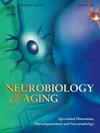Modeling the progression of neuropsychiatric symptoms in Alzheimer’s disease with PET-based Braak staging
IF 3.7
3区 医学
Q2 GERIATRICS & GERONTOLOGY
引用次数: 0
Abstract
In Alzheimer’s disease (AD), neuropsychiatric symptoms (NPS) correlate with tau deposition in the brain. Here, we investigated the association of PET-based Braak stages with NPS and assessed whether they predict annual changes in NPS. We evaluated 231 individuals in the aging and AD continuum. Participants were assigned a Braak stage at baseline and followed for 1.97 (s.d. 0.62) years. NPS were investigated using the Mild Behavioral Impairment Checklist (MBI-C) and the Neuropsychiatric Inventory Questionnaire severity (NPI-Q-S) and distress (NPI-Q-D) scales. Multiple linear regressions (MLR) assessed the association of Braak stages with baseline NPS and the annual change in NPS scores. At baseline, stages I-II, III-IV, and V-VI were associated with higher MBI-C, NPI-Q-S, and NPI-Q-D scores. Stages V-VI were associated with a significant annual increase in MBI-C scores. These findings suggest that tau accumulation may manifest clinically with an increase in NPS, which seems to be an early event in AD pathophysiology. Moreover, PET-based Braak staging appears to be a good predictor of NPS severity progression.
利用基于 PET 的布拉克分期模拟阿尔茨海默病神经精神症状的发展过程
在阿尔茨海默病(AD)中,神经精神症状(NPS)与大脑中的 tau 沉积相关。在此,我们研究了基于 PET 的 Braak 阶段与 NPS 的关联,并评估了它们是否能预测 NPS 的年度变化。我们对 231 名处于衰老和注意力缺失症连续体中的人进行了评估。参与者在基线时被分配了一个布拉克分期,并随访了 1.97 年(标准差为 0.62)。使用轻度行为损害核对表(MBI-C)和神经精神量表问卷严重程度(NPI-Q-S)和痛苦程度(NPI-Q-D)量表对NPS进行调查。多重线性回归(MLR)评估了布拉克分期与基线 NPS 和 NPS 分数年度变化之间的关系。基线时,I-II、III-IV 和 V-VI 阶段与较高的 MBI-C、NPI-Q-S 和 NPI-Q-D 分数相关。第V-VI期与MBI-C评分每年显著增加有关。这些发现表明,tau积累在临床上可能表现为NPS的增加,这似乎是AD病理生理学中的早期事件。此外,基于 PET 的 Braak 分期似乎可以很好地预测 NPS 的严重程度。
本文章由计算机程序翻译,如有差异,请以英文原文为准。
求助全文
约1分钟内获得全文
求助全文
来源期刊

Neurobiology of Aging
医学-老年医学
CiteScore
8.40
自引率
2.40%
发文量
225
审稿时长
67 days
期刊介绍:
Neurobiology of Aging publishes the results of studies in behavior, biochemistry, cell biology, endocrinology, molecular biology, morphology, neurology, neuropathology, pharmacology, physiology and protein chemistry in which the primary emphasis involves mechanisms of nervous system changes with age or diseases associated with age. Reviews and primary research articles are included, occasionally accompanied by open peer commentary. Letters to the Editor and brief communications are also acceptable. Brief reports of highly time-sensitive material are usually treated as rapid communications in which case editorial review is completed within six weeks and publication scheduled for the next available issue.
 求助内容:
求助内容: 应助结果提醒方式:
应助结果提醒方式:


